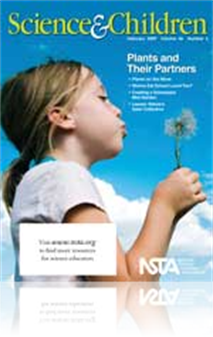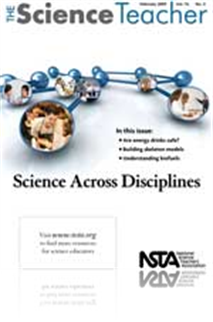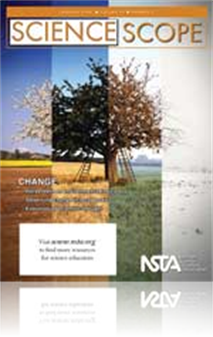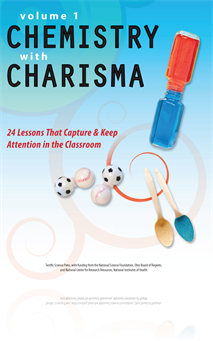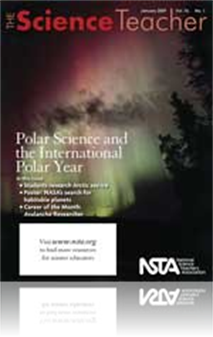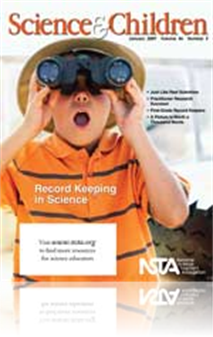All Resources
Journal Article
Leaves: Nature’s Solar Collectors
One of the most captivating things about plants is the way they capture the Sun’s energy, but this can be a difficult topic to cover with elementary students. Therefore, to help students to make a concrete connection to this abstract concept, this ...
Journal Article
Perspectives: Thinking About Thinking in Science Class
Self-regulated learners are able to set learning goals, find strategies that help them achieve those goals, and monitor their progress (Schraw, Crippen, and Hartley 2006). An important part of self-regulation is thinking about thinking, or metacognit...
Journal Article
When students classify, they embark on observing and identifying the properties of the object, and then they categorize, sort, group, organize, arrange, or grade objects into smaller and similar clusters or divisions. Therefore, observing and classif...
Journal Article
As part of the “Car Lab Project,” students constructed rubber band cars, raced them, and worked through a number of automotive activities. The students engaged in this project certainly had fun, but they also used high-tech gear such as motion se...
Journal Article
With the increasing popularity of energy drinks, I wonder—are these drinks safe? How do they affect teens? ...
Journal Article
Safer Science: The Safety Legal Paper Trail
To avoid the potential for litigation, teachers need to be informed. They must know how to prevent accidents and should be proactive to protect both themselves and students from harm in the classroom. The following actions are recommended to help tea...
Journal Article
Honeybees, Butterflies, and Ladybugs: Partners to Plants
Honeybees, butterflies, and ladybugs all have fascinating mutually beneficial relationships with plants and play important ecosystem roles. Children also love these creatures. But how do we teach children about these symbiotic interactions and help t...
Journal Article
Inductive and Deductive Science Thinking: A Model for Lesson Development
Middle school students make great learning gains when they participate in lessons that invite them to practice their developing scientific reasoning skills; however, designing developmentally appropriate, clear, and structured lessons about scientifi...
Journal Article
Every Day Science: February 2009
This monthly feature contains facts and challenges for the science explorer. ...
Journal Article
Thinking, Teaching, and Learning Science Outside the Boxes
In both universities and K–12 schools, students leave one world and enter another as they attend classes in discipline-specific domains. But how can students gain the experiences necessary to make discoveries—for personal satisfaction, for academ...
Journal Article
Career of the Month: An Interview With Pharmacist Ken Thai
Medications prescribed by your doctor are designed to support your health. But if incorrectly prescribed, misused, or abused, these prescriptions can become dangerous and sometimes fatal. A pharmacist’s job is to ensure that your medications and do...
Journal Article
Teaching Through Trade Books: Secrets of Seeds
From a tiny radish seed to a giant coconut, seeds come in a multitude of shapes and sizes. They all share one amazing secret: the potential to grow into a new plant when conditions are right. In this month’s column, students observe a variety of se...
Journal Article
Scope on the Skies: The new Milky Way galaxy
When students are asked about the Milky Way galaxy and where our solar system is located, most will describe it as a spiral-shaped galaxy with the Sun located on one of the spiral arms. While this is essentially correct, data obtained with the Spitze...
Journal Article
Issues In-Depth: Advancing understanding of drug addiction and treatment
While most school districts utilize a drug abuse resistance curriculum, as science teachers, it is our responsibility to understand the science behind drug addiction in order to most effectively educate our students against drug abuse. In the last tw...
Journal Article
What’s So Big About Being Small?
An interdisciplinary approach to teaching involves leveraging the different perspectives of each discipline to better understand an issue or problem. The most ideal topics for interdisciplinary study are those whose very nature is also interdiscipli...
Journal Article
Science Sampler: Dr. Vermeij and The Cay
As an interdisciplinary exploration, middle-level students were reading The Cay (1969) by Theodore Taylor in their English classes, honing map skills in social studies, and learning the importance of making observations in science class. Then, inspir...
Journal Article
Science Conversations for Young Learners
What do you get when you add 20 kindergarten students and a student-led science discussion for the first time? Mass chaos! So, after taking some time to recover, the authors began to reflect on what they could change to help orchestrate quality scien...
Journal Article
Creating a Schoolyard Mini-Garden
The creation of schoolyard gardens is a growing movement in the United States and around the world (Ballard, Tong, and Usher 1998; Pope 1998; Lewis 2004). It brings together all of the features of authentic hands-on science: Students can collect data...
Journal Article
The Interdisciplinary Study of Biofuels
From media news coverage to fluctuating gas prices, the topic of energy is hard to ignore. However, little connection often exists between energy use in our daily lives and the presentation of energy-related concepts in the science classroom. The con...
Journal Article
Editor’s Note: Plants and Their Partners
Plants are a ubiquitous piece of the elementary science curriculum. By the time they reach middle school, students have often grown enough bean seeds to feed a small city. Often these lessons don’t “grow” deeper ideas from the basic observation...
Journal Article
Instant Integration: Just Add Water
An instructional unit incorporating some of the Global Learning and Observation to Benefit the Environment (GLOBE) hydrology protocols provides an excellent way to connect academic learning, scientific inquiry, multiple subjects, and the values requi...
Journal Article
Tread Lightly: The Truth About Science Friction
During a recent unit on characteristics of animals in different environments, “backyard safari” trips around the schoolyard provided opportunities for students to describe ways that animals are adapted to their unique environments. This led to a ...
Journal Article
Methods and Strategies: Being Deliberate About Concept Development
In order to move students’ thinking from the exploration experiences to concept understanding (and thus the ability to then apply that understanding), teachers must deliberately consider students’ misconceptions, the intermediate steps to the acc...
Journal Article
Science Sampler: The Great Fakesperiment
The Great Fakesperiment is based on 10 fictitious experiment examples. These examples included a brief description of what the experiment was about, asked students to identify the independent or dependent variable, and listed possible answers. The ac...
Acquired Book
Chemistry With Charisma – Volume 1 – 24 Lessons That Capture & Keep Attention in the Classroom
How can a whoopee cushion inspire students’ enthusiasm for learning chemistry? With this powerful book, you will learn to use whoopee cushions—and many other fun items—to capture (and keep) attention in your classroom! Meaningful, motivating, a...
Journal Article
Science Sampler: Conceptualizing Moon Phases—Helping students learn how to learn
Helping students understand how to learn is an important goal for all subjects and levels of education. While this goal is highly regarded, promoting it is extremely difficult. Many times, we as teachers are consumed with how to better help our stude...
Journal Article
In this study, the authors examined students’ perceptions of their grades throughout an introductory biology course. Since large majorities of students prefer open-book exams (Moore and Jensen 2008); they sought to determine how these exams affect ...
Journal Article
Extracting the Max From a DNA Extraction
Students of all ages get a thrill out of actually seeing clumps or strands of DNA. The Biotechnology/Bioinformatics Discovery! Project, a professional development workshop offered to science teachers, has always included a DNA-extraction activity. Ov...
Journal Article
Isn’t forcing faculty to serve as evaluators of peers a lot to expect? To assign tenured professors to evaluate their colleagues is also not fair when the work is nerve racking, the time is demanding, and the stakes are high. Faculty evaluations ar...
Journal Article
From Aristotle to Today: Making the History and Nature of Science Relevant
Students connect to science in multiple ways. For some students, learning how real people have developed and defended their scientific ideas makes science relevant and interesting. Tracking the changes in scientific thought over time can be fascinati...
Journal Article
An Undergraduate Journal Club Experience: A Lesson In Critical Thinking
In an effort to better prepare undergraduate students to read and critically evaluate scientific literature, a journal club experience was introduced into a university's bachelor of science curriculum. As a result of this experience, students have be...
Journal Article
Career of the Month: Avalanche Researcher
Many of us enjoy snowboarding, snowshoeing, and other winter sports at the season’s first sign of snow. But what about when a massive amount of snow crashes down the mountain, gains speed and size with every second, buries everything in its path, a...
Journal Article
Green Science: Going locavore—Teaching students about the benefits of food produced locally
A term that is fairly new to the English vernacular is locavore. This term describes anyone who eats food that is grown locally. A locavore diet consists of both perishable and imperishable food that is generally produced within a 100-mile radius of ...
Journal Article
Editor’s Corner: Today’s Polar Science
The Earth’s polar regions once seemed a remote realm, accessible only through the compelling tales of intrepid explorer-scientists. Accounts of these polar explorers have long fascinated our imagination. Today, Earth’s polar regions are perhaps m...
Journal Article
Science Sampler: Seeing the world in a garden—Science and art curricula synergy
Duke Farms and Gardens, a 2,700-acre estate in Hillsborough, New Jersey, that includes a large greenhouse, was the site of a middle school field trip that provided the opportunity to highlight overlapping science and visual art curricula goals. Some...
Journal Article
Teaching With Web-Based Videos
Today, the use of web-based videos in science classrooms is becoming more and more commonplace. However, these videos are often fast-paced and information rich—science concepts can be fragmented and embedded within larger cultural issues. This arti...
Journal Article
Editor’s Note: Record Keeping in Science
Records show others what data you have collected and under what conditions. Without records, patterns escape notice. Records also provide accountability and allow someone else to replicate or analyze your methods. Record keeping is fundamental to sci...
Journal Article
How do you inspire students to keep records like scientists? Share the primary research of real scientists and explicitly teach students how to keep records—that’s how! Therefore, a group of third-grade students and their teacher studied the work...



